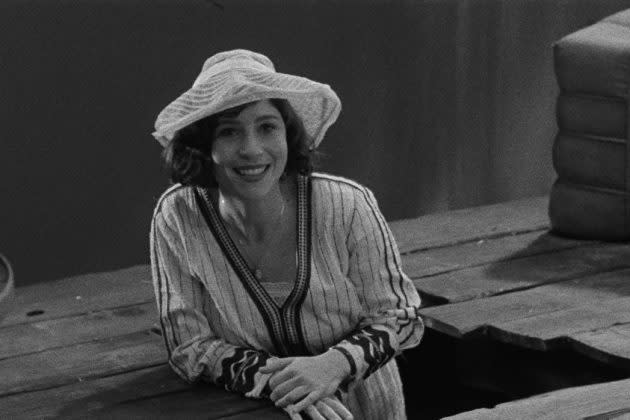‘Grand Tour’ Review: Miguel Gomes’ Dreamy, Delirious Time-Swirling Travelogue Through East and Southeast Asia

Our times are troubled, our burdens heavy, our passage through life often arduous and the bad kind of absurd. But for anyone feeling a pessimism creeping in like slow poison and taking the edge off any appetite for adventure, Portuguese singularity Miguel Gomes comes like a comet across the Cannes competition with “Grand Tour,” an enchanting, enlivening, era-spanning, continent-crossing travelogue that runs the very serious risk of infecting you with the antidote: a potent dose of wanderlust-for-life. “Abandon yourself to the world,” says one character, a Japanese monk prone to walking about with a wicker basket on his head, “and see how generous it is to you.” Abandon yourself to “Grand Tour” and reap similar, joyful rewards.
Monkeying around in time like a macaque in a hot spring, trundling through countries like a comically short-legged donkey on a jungle trail, yet somehow also peering down on the action from a lofty perch like a panda in the high bamboo, Gomes and co-writers Mariana Ricardo, Telmo Churro and Maureen Fazendeiro embark on this wildly ambitious East Asian itinerary on the slenderest of pretexts. We are never wholly sure why Edward (Gonçalo Waddington, who also appeared in Volumes 2 and 3 of Gomes’ sprawling “Arabian Nights” trilogy) doesn’t want to marry his fiancé of seven years, Molly (Crista Alfaiate, from all three “Arabian Nights” volumes, as well as Gomes’ last film, “The Tsugua Diaries”). Neither, it seems, is he.
More from Variety
All we know is that, when this low-level British diplomat (who, like all the British characters, whether they hail from London or pine for Yorkshire, speaks in Portuguese) shows up at Mandalay train station, it is 1918, near midnight and he is drunk. The next day, when he goes to pick Molly up from her arriving steamship, his nerve suddenly fails, and before he even claps eyes on her, he scarpers onto the next ship bound for Singapore.
But with Molly in pursuit, sending him regular, cheerfully terse telegrams about her impending arrival, he has to keep moving. He heads for Bangkok on a derailing train, then Saigon as a fishing-boat stowaway. In Manila he experiences “euphoric highs and hangovers” and hops an American warship to Osaka along with some sailors and sex workers. Ejected from Japan where they suspect him of spying, he is bounced to Shanghai, and thence to the interior of China, to Chongqing (by some metrics currently the world’s largest city), then Chengdu and then deeper into Sichuan province, with the goal of reaching Tibet in mind. Which is when, at about the midway point, we spin back and follow Molly instead, hot on the heels of Edward’s cold feet, as she has adventures and romances and setbacks of her own.
This is the story of “Grand Tour,” but it is not the half of “Grand Tour.” From the beginning, Gomes’ eccentric, puckish sensibilities are in evidence, with every beautifully rendered black-and-white, period-set interior alternating with bustling, bristling contemporary footage of the various towns and countries featured. Between 1918 and now, some of them have changed their names — Burma is now Myanmar, Siam is now Thailand — but none have changed their spirit, a fact that the seemingly reckless but actually deceptively meticulous construction makes clear.
Sometimes in color, sometimes in monochrome, with the narrators speaking the local lingo and knitting Edward and Molly’s colonial-era stories into the Asia of today, we get gorgeous on-the-fly snapshots of modern life across the continent. A rickety Rangoon ferris wheel propelled by hand (and foot). Workers untangling the wires atop Saigon’s overloaded telephone poles. Old Chinese men playing mahjong; Filipino locals riding tuktuks; Lunar New Year fireworks exploding over the Saigon skyline; a portly man in a restaurant moving himself to tears with his karaoke rendition of “My Way” before returning to his noodles, dabbing at wet eyes.
The film also has a recurring motif in the puppet shows that seemingly every culture has developed, and developed differently, as a storytelling medium. There are marionettes and paper silhouettes and two-person representations of — are they turkeys? Ostriches? Who knows? But that we always see the puppeteers as much as we see their puppets seems appropriate to the sense we get, throughout this overflowing cornucopia of worldly pleasures, of a single intelligence, a particular curiosity and a uniquely skewed sense of humor unifying so much that, in our darker moods, might seem actually to divide us.
Gomes shot this extraordinary film in an extraordinary way. Hampered by Covid-era restrictions, a lot of the modern footage — credited to three cinematographers in Rui Poças, Sayombhu Mukdeeprom and Guo Liang — was directed remotely, while the period segments, whether in bamboo forests or Raffles Hotel or aboard a ship whose captain speaks in six different languages over the mooing of a cargo hold full of cows, were creations on a sound stage. But even aside from the occasional deliberate anachronism — like a cellphone dropped in a forest when Molly is on the verge of catching up to Edward — and despite the brash collisions of stock and style, and scripted fiction and found-footage reality, “Grand Tour” is a remarkably coherent, if richly complex experience.
In one emblematic sequence, slow-motion Saigon scooters stream through the traffic-choked streets, while, of all the clichéd music in the world, “The Blue Danube Waltz” plays. The footage might be new, but the observation that Saigon has a traffic problem is not exactly novel. The music is old and its use as movie soundtracking hardly pioneering. Yet for some mysterious, magical reason, this moment, like so many others, may cause a kind of levitation in a certain kind of viewer: the kind who, looking for a reason to fall back in love with this world, can find it in “Grand Tour.”
Best of Variety
Sign up for Variety’s Newsletter. For the latest news, follow us on Facebook, Twitter, and Instagram.
